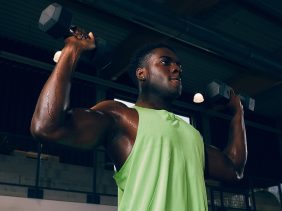Jumping Jacks can do it all: Cardio, interval, and even strength training
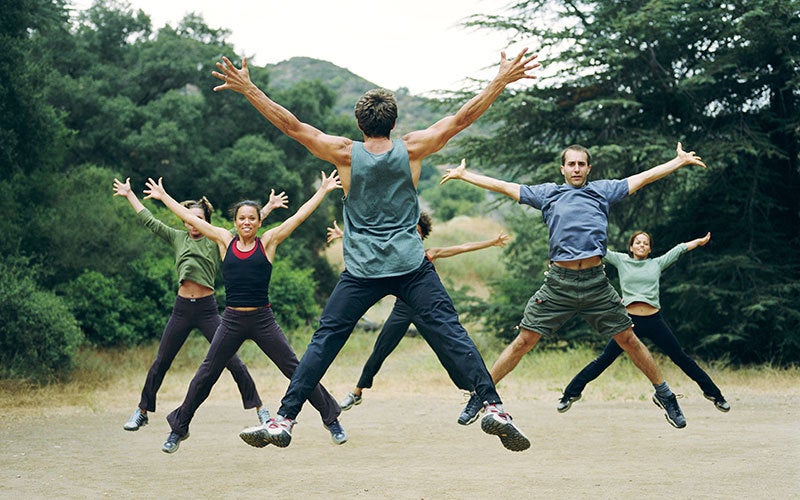 ©Mike Powell
©Mike Powell
Jumping jacks are the cardio exercise par excellence. Let’s get into what they really do for your body, how to do them correctly, and the best variations. Plus: a 30-Day Fat Burn Challenge!
What Are Jumping Jacks?
Named after the toy of the same name, this exercise was popularized in fitness legend Jack LaLanne’s TV show in the 1950s. Now many of us think they’re just child’s play because we suffered through them in physical education at school. But don’t forget about them just yet! Jumping jacks are an effective whole-body exercise, improving your coordination and cardio fitness, as well as strengthening your leg and upper body muscles.
This all-purpose exercise has become an integral part of bodyweight training – in both warm-ups and HIIT workouts.
To do a jumping jack, jump out with both legs to a broad stance, bringing your arms up over your head at the same time. Then jump back into the shoulder-width starting position and bring your arms back down, touching your hands together behind your back. The faster you move your arms and legs between these two positions, the more intensive the exercise will be.
What Are Jumping Jacks Good For?
Jumping jacks are mostly used as a cardio exercise because they’re performed continuously. But they can do so much more!
Because of the large range of motion involved in a jumping jack, all your joints start loosening up. That’s what makes them a popular warm-up exercise.
Depending on your speed, this exercise makes your heart rate go up quickly and increases the amount of calories you burn. No wonder they show up in so many interval training plans! Done slowly, jumping jacks are perfect for an active recovery phase during a HIIT workout or as a cool-down.
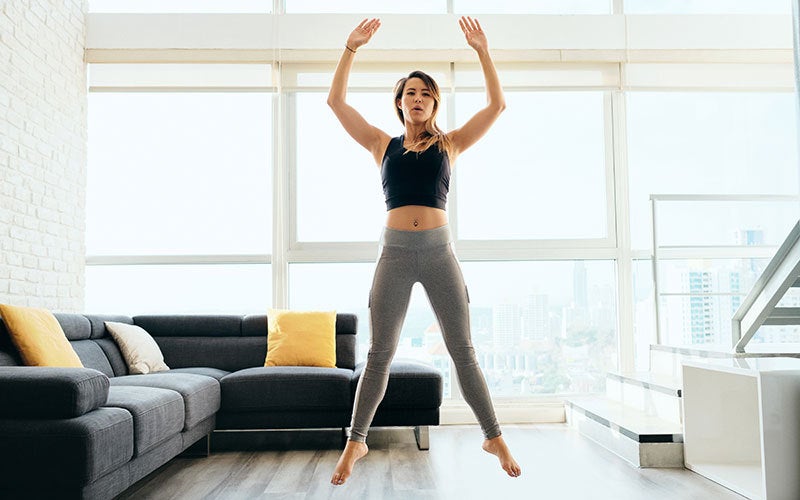
Their benefits as a strength exercise are also often underestimated. Your legs have to do a lot of work when jumping in and out from the feet-shoulder-width-apart starting position. Lifting and lowering your arms also strengthens the muscles in your upper back and shoulders. Keeping your muscles activated during the whole exercise is key.
At a glance: the advantages of jumping jacks
- loosen up joints and tendons
- activate and warm up the entire body
- raise heart rate
- increase calories burned
- strengthen leg, torso, and upper body muscles
- can serve as either an intensive cardio or an active recovery unit, depending on speed
Take a look at our workout page: It’s fully stocked with workout plans for every fitness level and goal – and best of all, it’s completely free!
Which Muscles Do Jumping Jacks Train?
Jumping jacks are a whole body exercise, so they involve many muscles and work both sides at once. The more you tense your body during the exercise, the more effectively you’ll build up muscles.
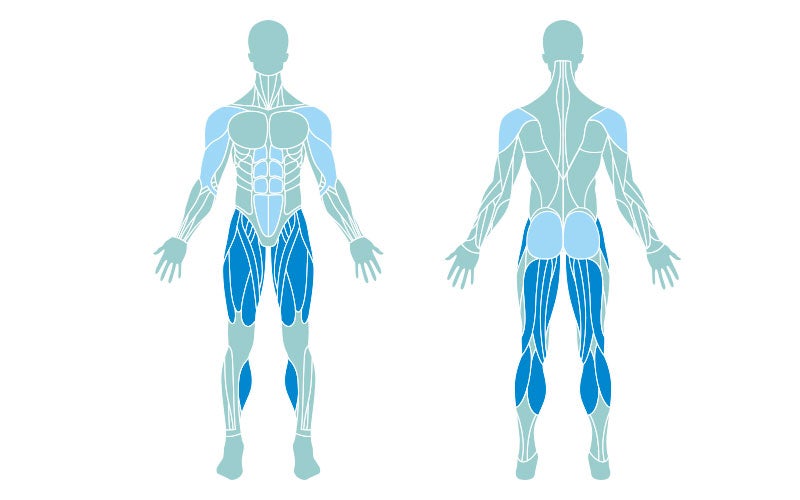
The following are the primary muscles used:
- Musculus quadriceps femoris / knee extensor / quads: The 4-headed leg extensor is responsible for extending the knee. In the classic jumping jack you never go into a full knee bend, but you do bend and extend your knees slightly during the jump, so the quads still have to work pretty hard.
- Biceps femoris / hip bender / knee flexor: This muscle flexes the knee, so it’s the counterpart to the knee extensor and involved in the jump.
- Musculus triceps surae / calf muscle: The calf muscles are active during push off and landing. They help flex the knee joint, as well as lowering and rotating the foot.
- Adductors: The adductors on the inside of the thigh help your legs jump from the broad stance back to their original position shoulder-width apart.
- Abductors: The abductors are located on the outer sides of the thighs. They help your legs jump out to the sides.
The supporting secondary muscles are:
- Gluteus maximus muscle / glutes: As you jump your legs apart, your glutes move your legs away from the center of your body. The gluteus maximus muscle is also responsible for rotating your legs out slightly and extending the hip.
- Musculus deltoideus / deltoid muscle: The deltoid muscle is the largest shoulder muscle and is especially active when raising and lowering the arms.
- Musculus brachialis and Musculus biceps brachii / upper arm muscles: You need your upper arms for all the arm movements, so these muscles are always activated.
- Rectus abdominis / Straight abdominal muscle: The frontal abdominal muscle is an important postural muscle. It helps you keep your balance during the jump.
How Many Calories Does This Exercise Burn?
The number of calories you burn with jumping jacks depends on many factors, such as age, height, gender, and weight, as well as the speed and general level of body tension.
If you have a body weight of 70 kg, the estimated rate is 50 calories per 5 minutes, i.e. 600 calories per hour.
In practice, not that many people do repetitive exercises like jumping jacks for an hour at once. Due to its effectiveness, however, it’s ideal as a sequence in a HIIT workout if you want to burn off a lot of energy in a short amount of time.
Get some inspiration for HIIT workouts at home or in the gym on our workout page featuring lots of free, intense training plans – including how-to videos!
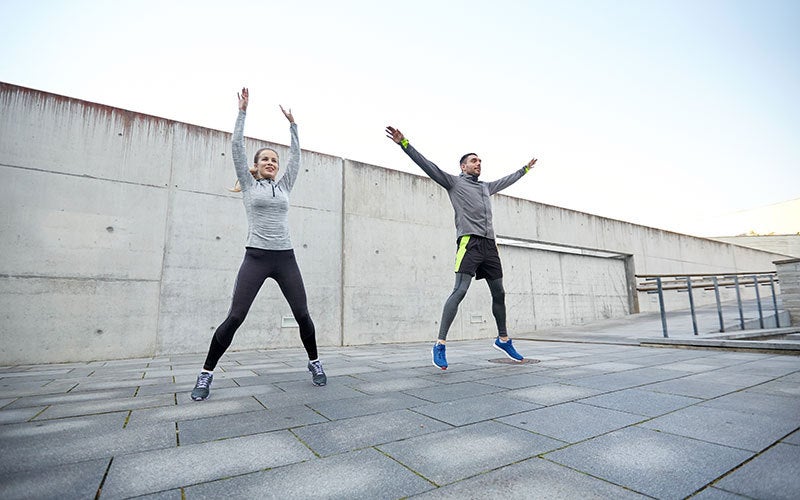
©dolgachov
Important note: Want to increase the amount of calories you’re burning in order to lose weight? Pay attention to your diet in addition to working out! Your body needs a healthy amount of carbs and proteins, as well as high-quality fats. Our Shape Shake 2.0 is designed for all those working on their fitness – it’s got a milkshake taste and can help you maintain or lose weight.
Execution: What’s the Right Way to do a Jumping Jack?
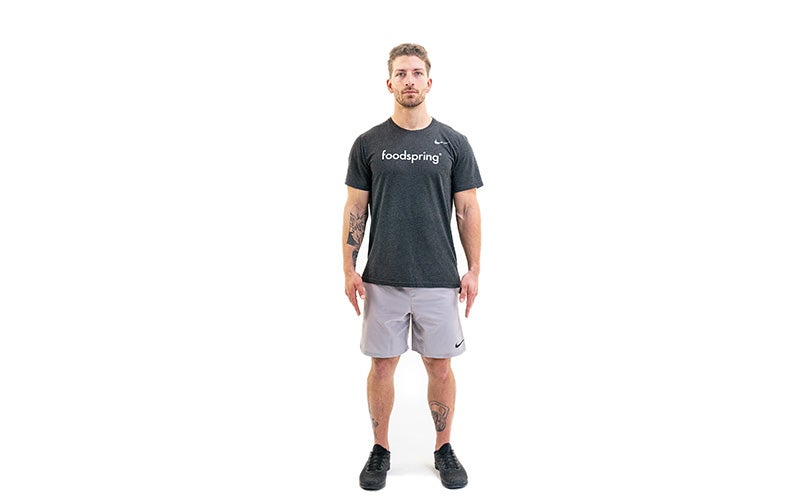
- Begin by standing up straight, with your feet placed shoulder-width apart. Your spine and neck stay aligned. Look straight ahead.
- Position your arms at your sides in the starting position. Pull your shoulder blades back and keep them there to avoid tensing your neck during the exercise.
- Jump off the floor by bending your knees slightly first and then pushing yourself off the floor. Your power mostly comes from your calves and thighs, but don’t forget to engage your core as well.
- During the jump, spread your legs and bring your arms together above your head at the same time. Your arms stay actively engaged and bent only slightly at the elbow.
- Land with your feet in a broad stance with your toes pointing outwards slightly. Put your hands together briefly above your head.
- Push off immediately and return to the shoulder-width starting position with both feet.
- At the same time, bring your hands together behind your back. Again, your fingertips can touch each other briefly. If you don’t have the necessary range of motion in your shoulders, just move your arms back down to your sides.
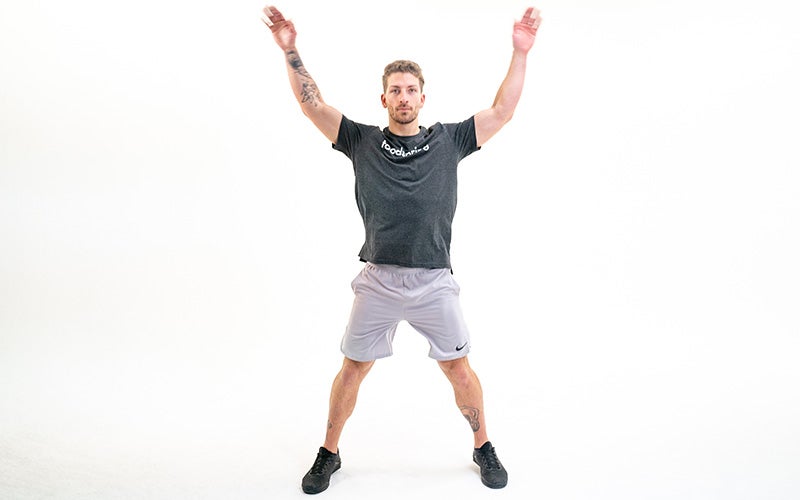
The jumping jack looks simple at first, but make sure to pay attention to the finer points in order to benefit from all its positive effects.
It’s important to maintain constant tension throughout your body: from your leg muscles to your abs and arms. Don’t let up, but consciously pay attention to keeping your muscles activated.
Make sure that you don’t fall into a bow-leg or knock-knee position, so that you don’t put unnecessary strain on your knees. Your toes should also point out slightly. Contracting your glutes will help you maintain the perfect position.
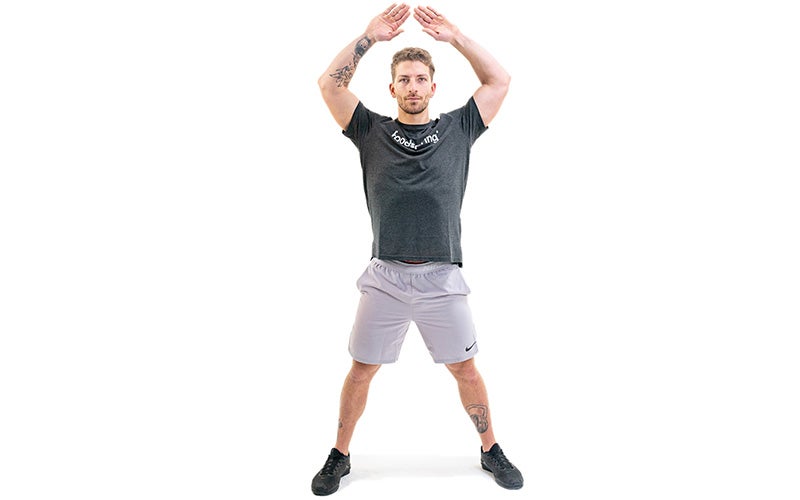
Our tip: The quieter you land, the more gentle the exercise will be on your joints and the more tension you’ll maintain in your body.
Jumping Jacks Variations
Jumping jacks are a classic basic exercise, but they can get boring! These variations will make your workouts not only more varied but also more intense.
Have a look at our workout page: Here you’ll find tons of workout plans for every level and fitness goal – completely free!
Front Jumping Jacks
For a front jumping jack, jump into a broad stance like jumping jacks, while opening your arms to the side instead. Bring them together in front of your chest during the jump back. In short: jump into a T-shape.
Weighted Jumping Jacks
Want to make your muscles really burn? Then grab a pair of dumbbells and lift them together over your head during the jump. You can put one weight in each hand or grab one weight with both, moving it up over your head and then back to your chest.
If you want to put extra strain on your legs, you can stretch a resistance band around your shins or right above your knees. This band forces your abductors to work extra hard during the jump.
Squat Jacks
Combine jumping jacks and squats to complete your leg day. You’ve got two options: Jump either from the jumping jack starting position directly into a squat with your arms above your head, or from the broad stance into a squat with your feet shoulder-width apart.
Criss Cross Jacks
For this jumping jack variation, cross your feet every time you jump back, landing with one foot right in front of the other, alternating legs with each jump.
Star Jumps
Begin in the starting position with your feet shoulder-width apart, and then go into a squat. When you jump up, spread your arms and legs out to the sides and back in before touching the ground again. Land with your legs in the squat and your feet shoulder-width apart again.
Plank Jacks
This exercise is a combination of planks and jumping jacks, so it’s a must-have in your six-pack workout. Start in a plank on your forearms with your elbows right below your shoulders. Or you can begin in the high plank position with your arms straight and palms on the floor shoulder-width apart. Begin with your feet together. Then jump into a V-position to the sides, like jumping jacks, without letting go of the tension in your core. Just move your legs, keeping your upper body and hips still.
30-Day Fat Burn Challenge with Jumping Jacks
Are you the “all or nothing” type and looking to set some personal records for yourself? Then our 30-Day Fat Burn Challenge is just the thing for you. Your body’s metabolism will increase from day to day, so you’ll really start feeling the burn, in more ways than one.
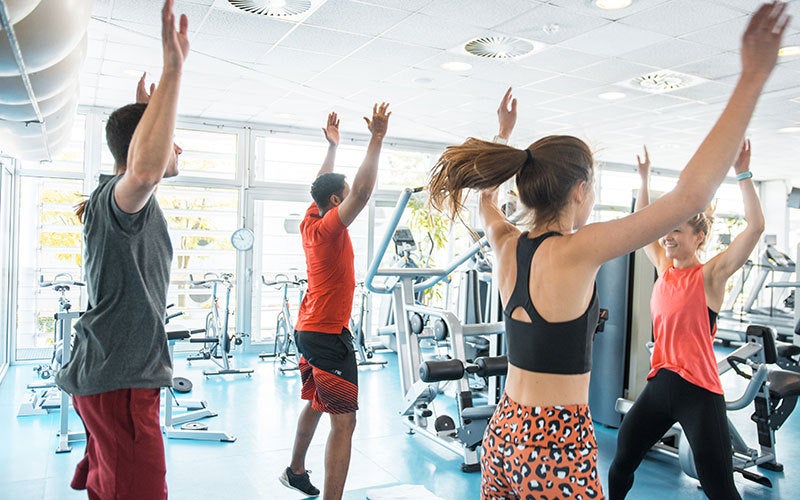
Thinking about a plan for strength training to supplement your challenge? Take a look at our numerous free workout plans and choose the one that’s right for you!
Here’s how the challenge works: Set a timer for 10 minutes, do as many sets of the following exercises as you can, and write down your results. Repeat the same exercises every 10 days so it’s easy to see the progress you’ve made!
| Day 1 | 10 Jumping Jacks, 10 Plank Jacks, 10 Squat Jacks |
| Day 2 | 10 Criss Cross Jacks, 15 Squat Jacks, 5 Star Jumps |
| Day 3 | 20 Jumping Jacks, 5 Star Jumps, 10 Plank Jacks |
| Day 4 | 20 Squat Jacks, 10 Plank Jacks, 10 Weighted Jumping Jacks |
| Day 5 | Rest |
| Day 6 | 25 Jumping Jacks, 5 Star Jumps, 15 Squat Jacks |
| Day 7 | 25 Plank Jacks, 20 Criss Cross Jacks, 10 Star Jumps |
| Day 8 | 25 Squat Jacks, 20 Jumping Jacks, 10 Weighted Jumping Jacks |
| Day 9 | 30 Jumping Jacks, 15 Weighted Jumping Jacks, 10 Criss Cross Jacks |
| Day 10 | 30 Plank Jacks, 20 Squat Jacks, 10 Star Jumps |
| Day 11 | 10 Jumping Jacks, 10 Plank Jacks, 10 Squat Jacks |
| Day 12 | 10 Criss Cross Jacks, 15 Squat Jacks, 5 Star Jumps |
| Day 13 | 20 Jumping Jacks, 5 Star Jumps, 10 Plank Jacks |
| Day 14 | 20 Squat Jacks, 10 Plank Jacks, 10 Weighted Jumping Jacks |
| Day 15 | Rest |
| Day 16 | 25 Jumping Jacks, 5 Star Jumps, 15 Squat Jacks |
| Day 17 | 25 Plank Jacks, 20 Criss Cross Jacks, 10 Star Jumps |
| Day 18 | 25 Squat Jacks, 20 Jumping Jacks, 10 Weighted Jumping Jacks |
| Day 19 | 30 Jumping Jacks, 15 Weighted Jumping Jacks, 10 Criss Cross Jacks |
| Day 20 | 30 Plank Jacks, 20 Squat Jacks, 10 Star Jumps |
| Day 21 | 10 Jumping Jacks, 10 Plank Jacks, 10 Squat Jacks |
| Day 22 | 10 Criss Cross Jacks, 15 Squat Jacks, 5 Star Jumps |
| Day 23 | 20 Jumping Jacks, 5 Star Jumps, 10 Plank Jacks |
| Day 24 | 20 Squat Jacks, 10 Plank Jacks, 10 Weighted Jumping Jacks |
| Day 25 | Rest |
| Day 26 | 25 Jumping Jacks, 5 Star Jumps, 15 Squat Jacks |
| Day 27 | 25 Plank Jacks, 20 Criss Cross Jacks, 10 Star Jumps |
| Day 28 | 25 Squat Jacks, 20 Jumping Jacks, 10 Weighted Jumping Jacks |
| Day 29 | 30 Jumping Jacks, 15 Weighted Jumping Jacks, 10 Criss Cross Jacks |
| Day 30 | 30 Plank Jacks, 20 Squat Jacks, 10 Star Jumps |
Conclusion
- Jumping jacks are an underrated, yet effective, whole-body exercise.
- Jumping jacks improve your endurance, coordination, and strength.
- As part of a warm-up, jumping jacks help loosen up your joints and raise your heart rate quickly.
- The more speed you pick up and the greater your body tension, the harder the jumping jacks will be for your leg and upper-body muscles, and the more calories you’ll burn.
- Jumping jacks are perfect for warm-ups, as a sequence in HIIT workouts, and – at a lower speed – for active recovery.
Sources for this article
We at foodspring use only high-quality sources, including peer-reviewed studies, to support the facts within our articles. Read our editorial policy to learn more about how we fact-check and keep our content accurate, reliable, and trustworthy.






























